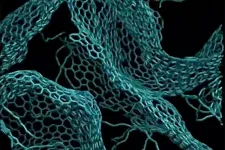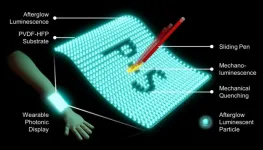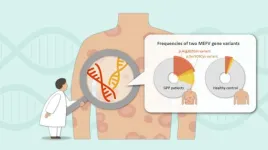(Press-News.org) Researchers from Carnegie Mellon University and Los Alamos National Laboratory have used machine learning to create a model that can simulate reactive processes in a diverse set of organic materials and conditions.
"It's a tool that can be used to investigate more reactions in this field," said Shuhao Zhang, a graduate student in Carnegie Mellon University's Department of Chemistry. "We can offer a full simulation of the reaction mechanisms."
Zhang is the first author on the paper that explains the creation and results of this new machine learning model, "Exploring the Frontiers of Chemistry with a General Reactive Machine Learning Potential," which will be published in Nature Chemistry on March 7.
Though researchers have simulated reactions before, previous methods had multiple problems. Reactive force field models are relatively common, but they usually require training for specific reaction types. Traditional models which use quantum mechanics, where chemical reactions are simulated based on underlying physics, can be applied to any materials and molecules, but these models require supercomputers to be used.
This new general machine learning interatomic potential (ANI-1xnr), can perform simulations for arbitrary materials containing the elements carbon, hydrogen, nitrogen and oxygen and requires significantly less computing power and time than traditional quantum mechanics models. According to Olexandr Isayev, associate professor of chemistry at Carnegie Mellon and head of the lab where the model was developed, this breakthrough is due to developments in machine learning.
"Machine learning is emerging as a powerful approach to construct various forms of transferable atomistic potentials utilizing regression algorithms. The overall goal of this project is to develop a machine learning method capable of predicting reaction energetics and rates for chemical processes with high accuracy, but with a very low computational cost," Isayev said. "We have shown that those machine learning models can be trained at high levels of quantum mechanics theory and can successfully predict energies and forces with quantum mechanics accuracy and an increase in speed of as much as 6-7 orders of magnitude. This is a new paradigm in reactive simulations."
Researchers tested ANI-1xnr on different chemical problems, including comparing biofuel additives and tracking methane combustion. They even recreated the Miller experiment, a famous chemical experiment meant to demonstrate how life originated on Earth. Using this experiment, they found that the ANI-1xnr model produced accurate results in condensed phase systems.
Zhang said that the model could potentially be used for other areas in chemistry with further training.
"We found out it can be potentially used to simulate biochemical processes like enzymatic reactions," Zhang said. "We didn't design it to be used in such a way, but after modification it may be used for that purpose.
In the future, the team plans to refine ANI-1xnr and allow it to work with more elements and in more chemical areas, and they will try to increase the scale of the reactions it can process. This could allow it to be used in multiple fields where designing new chemical reactions could be relevant, such as drug discovery.
Zhang and Isayev were joined by Małgorzata Z. Makoś, Ryan B. Jadrich, Elfi Kraka, Kipton Barros, Benjamin T. Nebgen, Sergei Tretiak, Nicholas Lubbers, Richard A. Messerly and Justin S. Smith. The project received funding from the Office of Naval Research (ONR) through Energetic Materials Program (MURI grant number N00014-21-1-2476) to Isayev.
END
Carnegie Mellon researchers develop new machine learning method for modeling of chemical reactions
2024-03-07
ELSE PRESS RELEASES FROM THIS DATE:
Embargoed: For childhood cancer survivors, inherited genetic factors influence risk of cancers later in life
2024-03-07
Common inherited genetic factors that predict cancer risk in the general population may also predict elevated risk of new cancers among childhood cancer survivors, according to a study led by researchers at the National Cancer Institute (NCI), part of the National Institutes of Health. The findings, published March 7, 2024, in Nature Medicine, provide additional evidence that genetics may play an important role in the development of subsequent cancers in survivors of childhood cancer and suggest that common inherited variants could potentially inform screening and long-term ...
New method to predict medical risks decades ahead
2024-03-07
[Vienna, March 5 2024] — The world population is aging at an increasing pace. According to the World Health Organization (WHO), in 2023, one in six people were over 60 years old. By 2050, the number of people over 60 is expected to double to 2.1 billion.
“As age increases, the risk of multiple, often chronic diseases occurring simultaneously—known as multimorbidity—significantly rises,” explains Elma Dervic from the Complexity Science Hub (CSH). Given the demographic shift we are facing, this poses several challenges. On one hand, multimorbidity diminishes ...
City of Hope-developed chimeric antigen receptor (CAR) T cell therapy shows clinical activity in patients with aggressive brain tumors in a Phase 1 trial
2024-03-07
LOS ANGELES — A pioneering Phase 1 CAR T cell therapy trial for the treatment of glioblastoma at City of Hope, one of the largest cancer treatment and research organizations in the United States, demonstrates promising clinical activity against incurable brain tumors, according to research published today in Nature Medicine.
The study, which is the largest reported trial to date of CAR T therapy for solid tumors, evaluated CAR T cells engineered to target the tumor-associated antigen interleukin-13 receptor alpha 2 (IL13Rα2), a product invented at City of Hope and exclusively licensed by Mustang Bio Inc. (Nasdaq: MBIO), a Fortress Biotech Inc. (Nasdaq: ...
STI cases on the rise across Europe
2024-03-07
The findings reveal a troubling surge in cases of syphilis, gonorrhoea, and chlamydia, indicating a pressing need for heightened awareness of STI transmission, and the need to enhance robust prevention, access to testing, and effective treatment to address this public health challenge.
In 2022, the number of reported cases saw a significant increase compared to the previous year, with gonorrhoea cases rising by 48%, syphilis cases by 34%, and chlamydia cases by 16%. In addition, cases of lymphogranuloma venereum (LGV) and congenital syphilis (caused by transmission from mother to fetus) have also substantially increased.
These trends underscore the urgent need for ...
Foot-eye coordination: how our vision changes in rhythm with our walking
2024-03-07
For the first time, neuroscientists have established a link between shifts in our visual perception and the cadence of our steps while walking.
The research, published in Nature Communications, shows that the brain processes vision in a rhythmic manner, rising and falling in sensitivity in a cycle that corresponds to the rhythm of our steps. When swinging from one step to the next, human perception is good and reactions fast.
During footfall, however, our vision is not as sharp and reactions are slowed.
Lead author Dr Matthew Davidson from the School of Psychology at the University of Sydney said: “This work reveals a previously unknown relationship between perception ...
Researchers discover new cancer-fighting role for neutrophils
2024-03-07
In a study published in Cell on March 5, Prof. ZHANG Xiaoming at the Shanghai Institute of Immunity and Infection (SIII) of the Chinese Academy of Sciences and Profs. GAO Qiang, FAN Jia and YANG Li at Fudan University have uncovered an unexpected level of complexity hidden within neutrophils, which were previously thought to be a relatively uniform population of short-lived immune cells.
Using cutting-edge single-cell RNA sequencing technology, the researchers analyzed individual neutrophils across a remarkable 17 different cancer types from 143 patients. They revealed that neutrophils can adopt at least ...
Personality and mental health factors linked to vaping uptake
2024-03-07
University of Otago researchers have discovered three psychological factors that predict if a non-smoker will start vaping.
The study, published in the journal Drug and Alcohol Review, investigates how psychological traits related to personality and mental health predict the likelihood of vaping uptake over time in non-smoking adults.
Researchers, led by Professor Tamlin Conner of the Department of Psychology and Andre Mason of the Department of Psychological Medicine, analysed longitudinal data of more than 36,000 New Zealand adults from the New Zealand Attitudes and Values Study (NZAVS).
They found people who ...
Powerless mechanoluminescent touchscreen underwater
2024-03-07
Optical properties of afterglow luminescent particles (ALPs) in mechanoluminescence (ML) and mechanical quenching (MQ) have attracted great attention for diverse technological applications. Recently, a team of researchers from Pohang University of Science and Technology (POSTECH) has garnered attention by developing an optical display technology with ALPs enabling the writing and erasure of messages underwater.
The team, comprised of Professor Sei Kwang Hahn and PhD candidate Seong-Jong Kim from the Department of Materials Science and Engineering at the POSTECH, uncovered a distinctive optical phenomenon in ALPs. Subsequently, they successfully created ...
Missing disease-related gene identified in generalized pustular psoriasis
2024-03-07
A team from Nagoya University in Japan has identified previously unidentified gene variants that are associated with the development of generalized pustular psoriasis (GPP). The team’s findings, published in the Journal of the American Academy of Dermatology, offer hope for improving diagnosis and therapy.
GPP is rare, but its effects are often serious. People with GPP can experience recurrent flares of the disease, which include multiple erythematous lesions and sterile pustules over the whole body, often accompanied by fever ...
Schisanhenol: A potential drug for the treatment of cytokine storm
2024-03-07
Background and objectives
Cytokine storm (CS) is an acute systemic inflammatory response with limited effective interventions up to now. The treatment experience of the COVID-19 pandemic suggests great potential in the intervention of CS by herbal medicine. This study aimed to investigate whether Schisanhenol (SSH), an active component of the Chinese herbal medicine Schisandra chinensis, has the potential to interfere with CS.
Methods
The effect of SSH on nuclear factor-kappa B (NF-κB) signaling pathway activity ...







